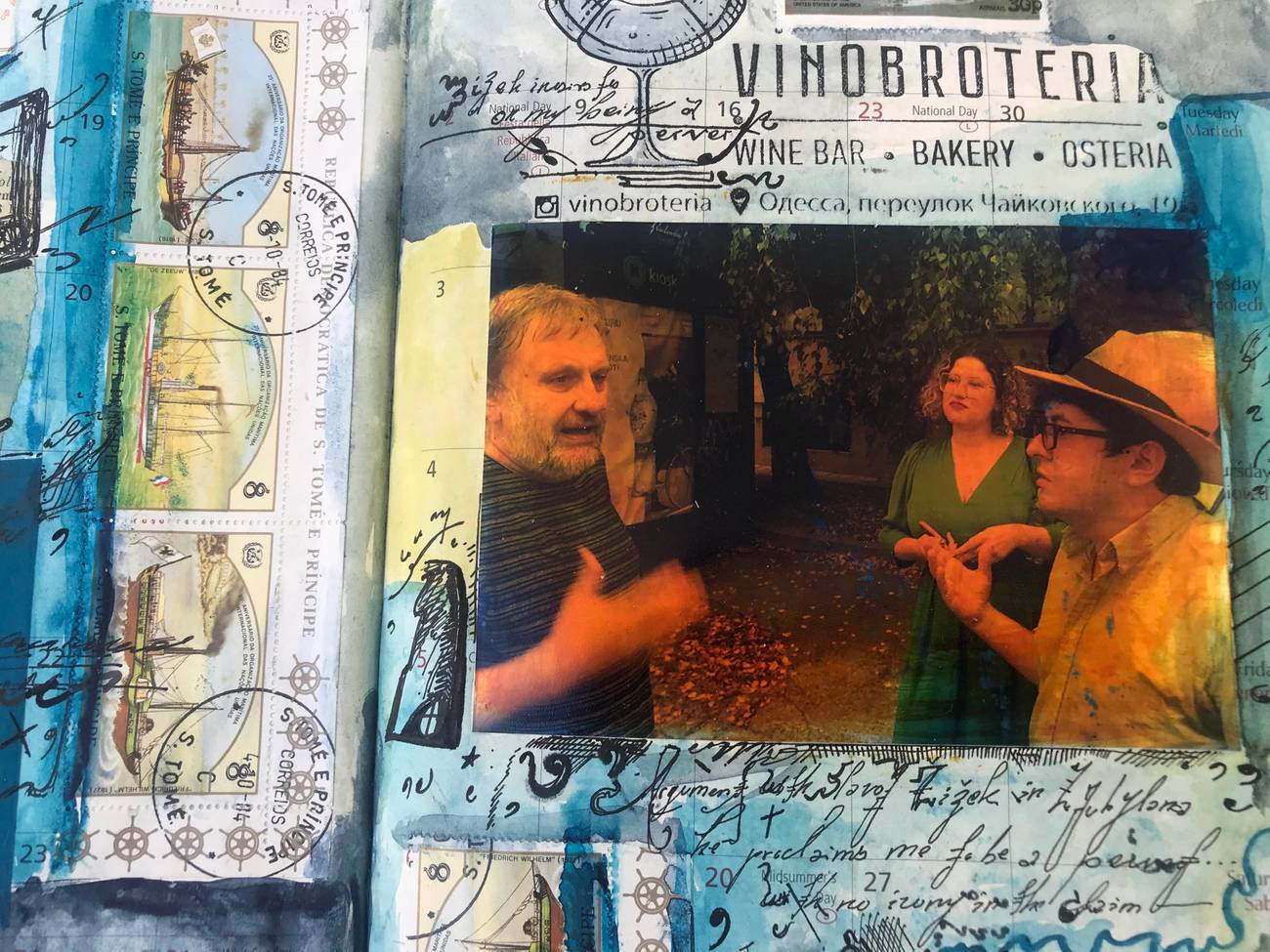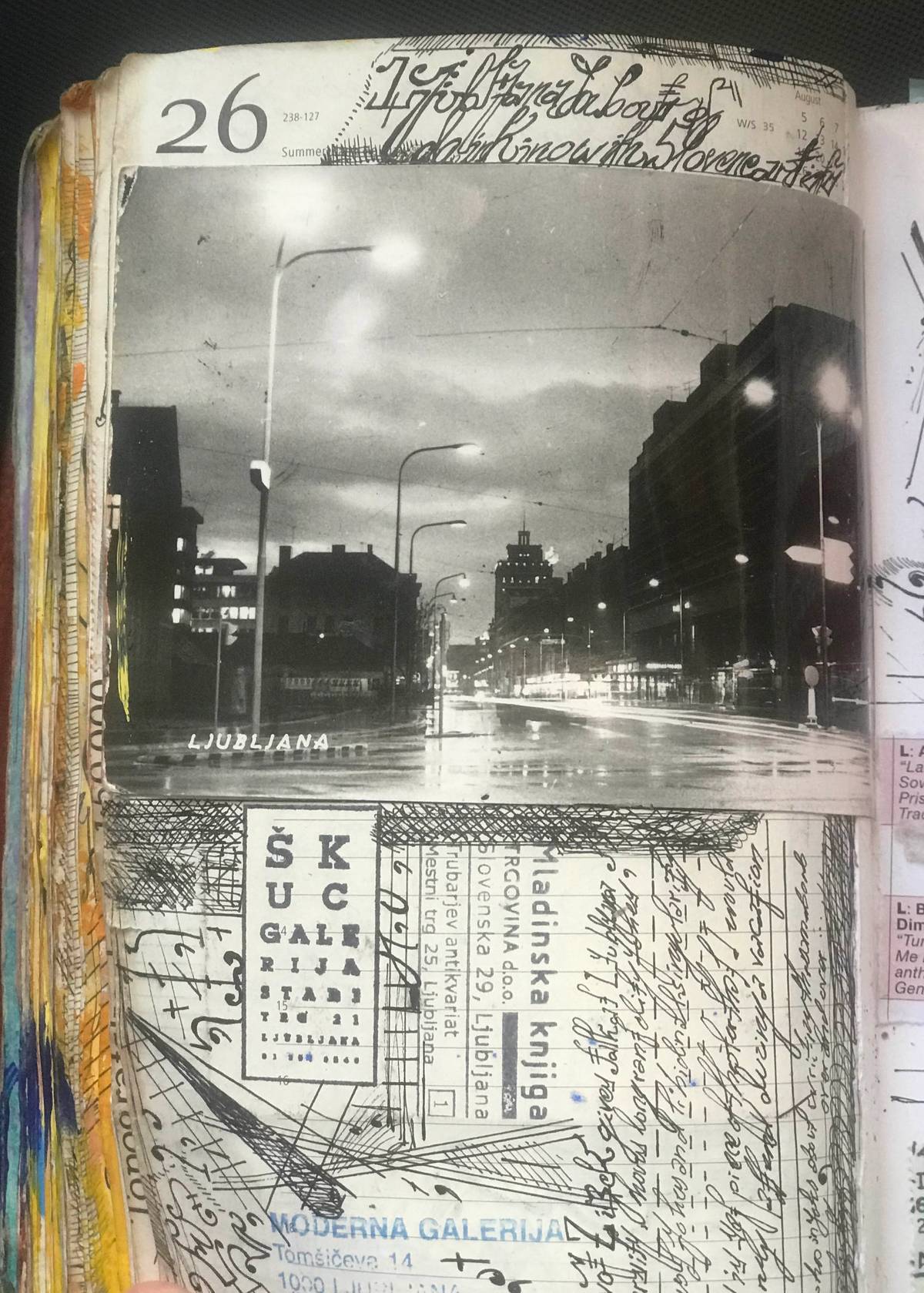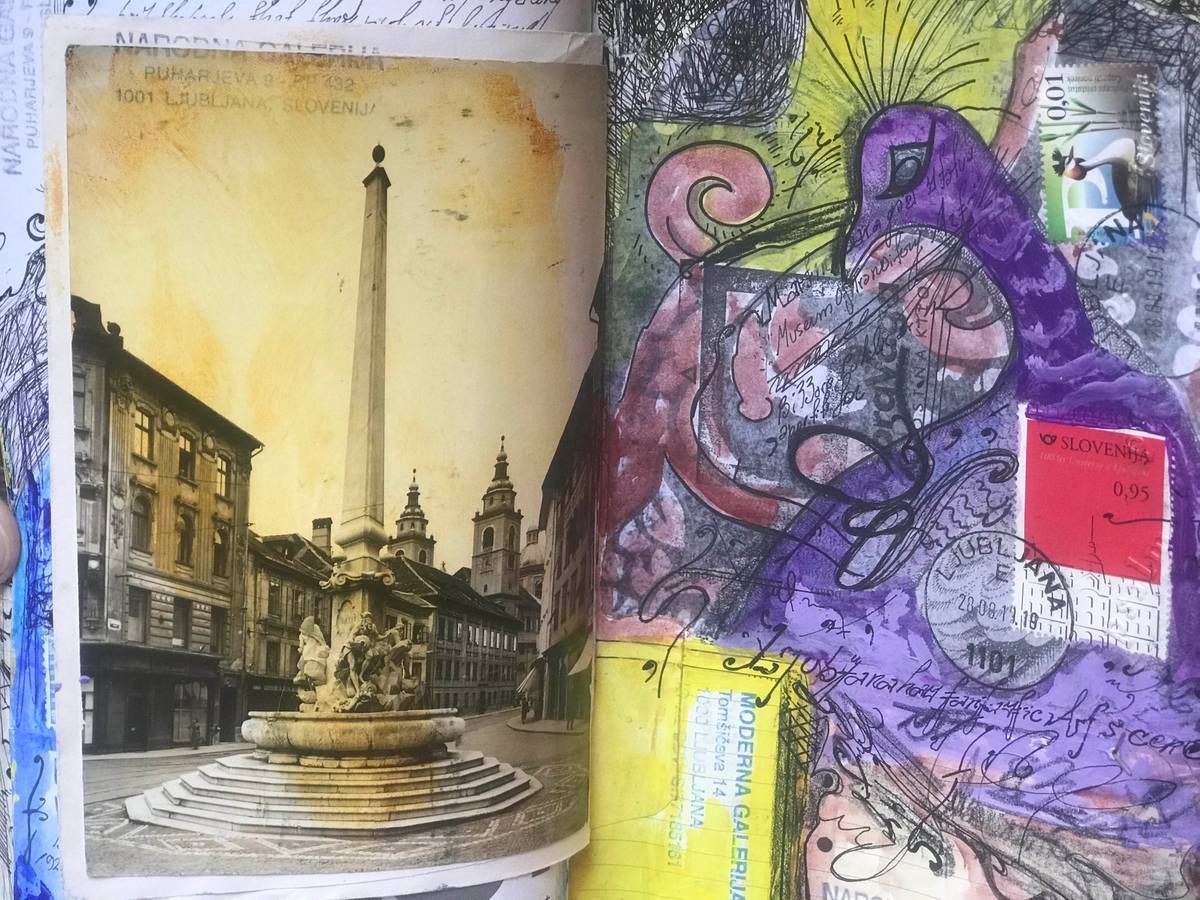A Ljubljana Fairy Tale
Before the plague, in the Slovenian art-world destination with a Cyanometer, Rambo Amadeus, and Slavoj Žižek



This tale of adventure and travel in a faraway magical kingdom took place a long time ago, in the innocent time before the plague, before all of us became collectively transformed into neurotic hypochondriacs who forfeited all forms of civilized pleasure. Before the rapid reestablishment of borders in the European Union reversed several decades of integration and globalization. In that long-ago era one could still travel the world on an American passport—which is now about as useful a travel document as one issued by the bygone Socialist Federal Republic of Yugoslavia. To be exact, this visit to Slovenia’s magical and fantastically weird art-world capital of Ljubljana took place last summer. I am writing about it now because it is the summer, and like most others, I spend a depressing percentage of my time stuck indoors. Ah, memories!
Last summer, while visiting an artist friend at her artist residency in northern Croatia, I learned that an intriguing “summer school” conference on the legacies of the 1990s Avant-Gardes, would take place at the Moderna Galerija in Ljubljana. The conference would be an ancillary stop along the Silk Road of the European art world, a brief interlude between Art Basel and the Art Bienniale in neighboring Venice. Ljubljana is in fact an excellent city to visit before one arrives in Venice, whose proximity has historically shaped the production of the Slovenian art scene. The prophetic theme of last year’s Bienniale was “May You Live in Interesting Times.”
Decamping in Ljubljana, one arrives in a provincial capital whose puckish majesty is suffused with a streak of bizarro quirkiness. Populated by a mixture of Germans and Slavs, Slovenia had been a constituent crown land of the Hapsburg monarchy for almost three-quarters of a millennium. Thus Ljubljana can be thought of as either a Balkan city on the rim of the German lands or else a Germanized capital city protruding into the Balkans.
Slovenia emerged as undoubtedly the least traumatized of the constituent republics of the Socialist Federal Republic of Yugoslavia. It was the first one to leave the federation, and was lucky to have escaped Belgrade’s orbit after a 10-day war that killed a mere six people or so a day. It is likely the only post-Yugoslav nation to have avoided the trauma of dissolution.
Slovenia contains a tremendous number of dialects across a very compact country and remains home to substantial diasporas from the other former Yugoslav nations. Its exquisite oddness is difficult to pin down: An admiring American journalist who spent time there during the Yugoslav wars described it to me as a “town in Oregon which had been settled in 1928 by refugees from Weimar Berlin.” Friends inform me that it has also retained the Yugoslavian patrimony of mixed marriages being common.
If Slovenia really is the archetype of the miniaturized Mitteleuropean snow-globe fairytale kingdom, it makes a perverse sort of sense that America’s ambivalent first lady had to flee it in order to secure a starring role in a much darker and more flamboyant fairy tale. Conservative populist Prime Minister Janez Jana, leader of the Slovenian Democratic Party is a member of the generation of Central and Eastern European anti-communist activists who later soured on the European Union and the prevailing liberal consensus of Western Europe. He is a committed ally of Hungarian Prime Minister Viktor Orbán (some refer to him as a poor man’s Orbán) known for scolding his journalist enemies as “presstitutes”—a phrase that Donald Trump might envy.

Unlike many other post-socialist capitals, the old city remains unscarred and was never ruined. Soviet Realist and Brutalist architecture—which is now fashionable again—has some of its finest examples in Ljubljana and its environs, and Yugoslav-era architecture buffs continue to make pilgrimages to see structures such as Valentin Jeck and Milan Mihelič’s levitating S2 Office Tower. Conveniently located anarchist-art squats in converted former Austrian imperial army barracks are in use long after such spaces had been banished from the downtowns of most European capitals. The city is likewise an outpost of Viennese modernism: Sumptuous examples abound of the Art Deco and Secessionist buildings built by architects who had also labored in Vienna, Prague, and Budapest, and masterpieces of period decoration adorn the vaulting ceilings of even medium-size banks.
I had been forewarned that the Slovenian arts scene was fecund, irreverent, and influential out of all proportion to the nation’s population, wealth, or geopolitical importance. The Ljubljana city center features some of the most fantastical and outlandish public art that I have encountered anywhere. Atop one bridge one finds a pair of engorged egg men cast in brass, tongues jutting out of their bloated faces in a manner that would have pleased the master of the insidious frown, Franz Xaver Messerschmidt. A ferocious wolf-dog with spindly apertures along its arched metallic back lowers its snout in a show of pensive shame.
The Mesarski most—the Butchers’ Bridge—spanning the Ljubljana river (it was known as the “Sava” in German medieval manuscripts, but confusingly in modern times this became the name of another tributary of the Danube) is lined by a trio of truly frightening figures. One of these is a headless, armless, and disemboweled Prometheus sprinting madly across the bridge with his rib cage exposed to the elements. By contrast, the early-20th-century sculpted dragon statues perched atop a neighboring bridge look like friendly American cartoon dragons. At the beginning of July, a bizarre (and horrific) wooden public sculpture of Melania Trump that an American artist had erected near the first lady’s hometown was set ablaze.
Yet, I was still unprepared for how dynamic this small city would turn out to be, swarming with artists and Balkan intellectuals, many of whom were supported in the most glorious and decadent fashion by the Slovenian Ministry of Culture.
Late one evening I found myself at a table drinking with the charismatic Slovenian artist Martin Bricelj Baraga, the mastermind and creator of Ljubljana’s most striking and curious public sculpture: the Cyanometer. Habitually dressed in the art-world uniform of black, Baraga has sandy blond hair and the thick, rounded shoulders that mark him off to me as a fellow Slavic muzhik. He is the director of MOTA—the Museum of Transitory Art, which appropriately enough at this moment does not exist as a brick-and-mortar institution in our merely transitory reality.
The translucent blue Cyanometer is a shimmering obelisque whose function is to measure the air quality in the city. The monument continually morphs color in order to match the hue of the sky. The 10-foot-tall structure is an homage to the original cyanometer, which was invented by the 18th-century Swiss scientist Horace-Bénédict de Saussure.
“I am interested in art- and technology-based pieces which connect us to our environment,” Baraga informed me in the midst of our third bottle. ”When I had first created the piece, the air quality in European cities was nowhere as bad as it is now. I imagined that people would view it as a totemic form, or a mystical gate to infinity but people soon began to use it also in a way as their personal data visualizer.”
Baraga was expansive on the subject of Ljubljana’s appealing mixture of constituent ingredients: “The mentality of the people here is more Mediterranean than that of the other Slavic countries. We have a mixture of Italian and German character traits, as we border the Italian, Germanic, and Balkan worlds. It is indeed remarkable how developed Ljubljana is in various spheres of art, despite its small size, it has a rich ecosystem of arts foundations and NGOs, which is a byproduct of the civil movements that began in the ’80s when artists and intellectuals began to think about constituting a new state. Slovenia at that time became known for its forward-looking ecological NGOs and yes, sometimes there is a bit of hyper or even overproduction of interesting work being made here.”
Despite the fecundity of art production in the capital there is no art market, Baraga confirmed to me. That is partly because of the munificent state funding that is another part of the legacy of Yugoslav socialism, and which accounts for much of the sense of artistic freedom here.
Slovenia’s greatest contribution to contemporary art and human civilization is obviously and unambiguously the collected works of the Neue Slowenische Kunst collective as well as the music of Laibach. Starting in the mid-1980s, the NSK mocked and subverted the symbols of the Yugoslav state and made people uncomfortable with a series of provocative, ambiguous, Dadaist political gestures. As the socialist dream began to crumble in the Balkans—turning into fratricidal nightmare that would kill at least 130,000 people who had recently been singing songs of brotherhood—the NSK represented a utopian attempt to found a “state without a state.” This anarchic art-state would be complete with consulates, passports, and ironical national anthems sung by mustachioed hipsters dressed up as Nazis: “Laibach” is the traditional German name for the city and the group’s use of it 40 years after Hitler, while wearing mock-up Nazi uniforms, achieved the intended results. The entire project was carried along by a particularly Slovenian and Central European brand of insouciant irony.
Attending lectures and art openings, I was delighted to see that the legacy of the NSK still held sway, with its founding members treated as a de facto art-world aristocracy at parties and openings. One founding member of Laibach and the NSK whom I was introduced to, a lanky, half-crazed drunken bohemian dressed in rags straight out of central casting, greeted me with a performative half-Hitler salute and grin. This was a gregarious act of generosity on a certain register: The professional trickster would not have wanted to disappoint a visiting guest. Another founding member of the NSK whom I became engaged with in conversation at the same party also conspiratorially informed me that he was a proud crypto Jew, with the family having been Slovenianized—but that I should be discreet about his name. Of course, the fact that one of the progenitors of Laibach’s mock-fascist aesthetic is discreetly Jewish was not in the least surprising.
The Avant Garde Legacies conference turned out to be filled with talks documenting obscure decades-old Russian conceptual art. A famous Russian art theorist bragged to me about not having slept in the same city for more than three nights in a row for over two decades. There was also a hilarious presentation on the political legacy of Balkan turbofolk. The militarized and ineffable music genre characterized by the ironical use of rap and techno beats over traditional Balkan folk music is similar to Laibach’s project, though aimed at a less artsy demographic. Turbofolk’s great progenitor and guru is of course “Rambo Amadeus the World Kilo Tzar.”
One of the most buzzed-about lectures at the conference was the guest appearance of Slavoj Žižek, as the unkempt wild man superstar of critical theory returned to his hometown to play his greatest hits. Though some people would prefer to perform a root canal upon themselves with a rusty pair of pliers sans painkillers, the idea of attending a free-associative Žižek lecture at Ljubljana University amused me, as the touristic-zoological analogue of glimpsing a wild panda gnawing on bamboo in the dwindling Chinese forest.
The lecture was composed of Žižek’s usual Stalinist-standup-by-way-of-Lacanian-dialectic comedy routine. I had imagined that one could sneak away during the intermission as one does during a bad play, but Žižek wound up rambling at astronomic speed without interruption for his entire allotment of three hours. The lecture was carried along by his berserk inner compulsion to ensure that not a single nanosecond be spent in silence. He assaulted us with a torrent of mutable concepts filched from German philosophy and encrusted with a repertoire of smutty Balkan jokes. Hegel’s phenomenology through a counterintuitive reading of Oedipus Rex. Lacanian theory and The Simpsons. The perversity of the Hollywood Jews who loved Hitler. The implicit carnal violence of ideology in opera. The fact that tolerance in socialist Yugoslavia was rooted in the custom of telling racist jokes.
Playing impishly to his home crowd, Žižek prepared us gleefully for the most outrageous Balkan race jokes with the correct caveat “that this would get me canceled in America!”: The widow of a man killed in the Srebrenica massacre is handed a bag of severed penises so that she might identify her husband; she goes through all of them rejecting them one by one, declaring that the last one was not even from Srebrenica.
“Kant is the most subversive when he talks about ravishing the cow in the Lacanian fashion rather than the Balkan Hegelian missionary fashion” (I made that last one up, but it is representative). Was not all of this obvious!? Freud knew all of this! He was an Eastern European Jewish sage! Freud was the most Balkan of all!

The audience of art-world denizens and assorted hipsters assembled from across the four corners of Europe scribbled notes earnestly, though it was impossible to imagine what they could possibly have learned from this soup of extemporaneously delivered babble. More than a decade ago, my Tablet colleague Adam Kirsch pronounced Žižek to be a “deadly jester,” identifying him as a serious threat to liberalism in a much-discussed essay in The New Republic. When I had read the essay, I thought it was at once hyperbolic and at the same time fairly prim. Yet, watching these amused kids imbibe Žižek’s totalitarian ideas along with the jokes, I realized that Žižek’s antics had indeed played a foundational role in the decadelong process that has brought us to our current illiberal predicament. Time has proven Kirsch’s judgment to have been fundamentally right.
A mutual acquaintance had arranged for a meeting with the sage of Ljubljana after the conclusion of his virtuoso logorrhea. An exhausted-looking Žižek was waiting for me and his taxi outside of the granite Social Realistcorpus of the University Arts Faculty. Visibly cranked up on plunging adrenaline from his manic rambling, he looked as if he was about to crater into methamphetamine withdrawal.
Learning that I had been born in Uzbekistan, Žižek deftly deployed yet more recycled standup material. He engaged me in a spontaneous argument about which Central Asian nation boasted the most picaresque dictatorship.
The conversation became very excitable very quickly for no easily discernible reason. We both began waving our hands around. Finally, Žižek accused me of being a pervert. Of course, in his parlance this likely meant that I was a decent sort of fellow, and anyway one had to admit that he was not entirely incorrect. Having made new friends, the “Elvis of critical theory” executed a sharp parachutist leap into an oncoming taxi and sped away in palpable terror of further human interaction.
In Paris now, where everyone wears masks on the street, I revisit my Ljubljana at night the way that other men my age might revisit the pressing erotic high points of their early to mid-20s, which can only gain by contrast with the sordidly depressing limits of the present, which is characterized by an alphabet soup of humorless identitarian idiocy of the sort that Žižek would claim to despise but actually helped forge—and by the virus, of course. One day, I promise myself, I will go back there. So must we all.
Vladislav Davidzon is Tablet’s European culture correspondent and a Ukrainian-American writer, translator, and critic. He is the Chief Editor of The Odessa Review and a Non-Resident Fellow at the Atlantic Council. He was born in Tashkent, Uzbekistan, and lives in Paris.